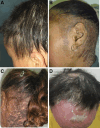Alopecia patterns and trichoscopic findings in patients with autosomal recessive congenital ichthyosis
- PMID: 39170880
- PMCID: PMC11338256
- DOI: 10.1097/JW9.0000000000000175
Alopecia patterns and trichoscopic findings in patients with autosomal recessive congenital ichthyosis
Abstract
Background: Autosomal recessive congenital ichthyosis (ARCI) is a rare genodermatosis categorized among nonsyndromic ichthyoses. While ARCI patients often manifest hair abnormalities, their impact on the quality of life remains underreported in the literature.
Objective: This study aims to comprehensively characterize the clinical and trichoscopic findings of alopecia in ARCI patients.
Methods: A prospective study spanning from January 2019 to December 2021 (3 years) was conducted at the Dermatology Department of Habib Thameur Hospital, Tunis, Tunisia. Clinical and trichoscopic examinations were performed on the hair of the participants, with molecular studies conducted on 15 patients.
Results: The study included 30 patients, predominantly female (male/female = 0.58), with a mean age of 20 years. Twenty-eight patients were born from consanguineous marriages. Lamellar ichthyosis was observed in 22 cases, while congenital ichthyosiform erythroderma and bathing suit ichthyosis were each present in 4 cases. The ARCI severity score, assessed using the Visual Index For Ichthyosis Severity scale, had a mean value of 15 (4-28). Alopecia emerged as a prominent finding in 11 patients, presenting as hairline recession (13%), multiple patchy alopecia (27%), and alopecia of the eyebrows (13%). Trichoscopic findings included interfollicular and perifollicular scaling, perifollicular lamellar hyperkeratosis, peripilar casts, interfollicular erythema, loss of hair openings, predominance of single hair follicles, broken hair, vellus hair, anisotrichosis, pili torti, dystrophic hair, and comma hair. Several trichoscopic findings showed statistically significant associations with the severity of ARCI.
Limitations: In our study, we only included 30 patients due to the rarity of this genodermatosis.
Conclusion: Contrary to previous perceptions, alopecia is a notable finding in ARCI, particularly in patients with a severe form. This study provides a detailed characterization of alopecia in ARCI, shedding light on its prevalence and associated trichoscopic features, thereby enhancing our understanding of this dermatological condition.
Keywords: alopecia; hair; ichthyosis.
Copyright © 2024 The Authors. Published by Wolters Kluwer Health, Inc. on behalf of Women’s Dermatologic Society.
Conflict of interest statement
None.
Figures


References
-
- Rodríguez Pazos L, Ginarte M, Vega A, Toribio J. Autosomal recessive congenital ichthyosis. Actas Dermosifiliogr 2013;104:270–84. - PubMed
-
- Bolognia JL, Schaffer JV, Cerroni L. Dermatology. 4th ed. China: Elsevier Masson; 2018. p. 2880.
-
- Takeichi T, Akiyama M. Inherited ichthyosis: non-syndromic forms. J Dermatol 2016;43:242–51. - PubMed
-
- Oji V, Tadini G, Akiyama M, et al. . Revised nomenclature and classification of inherited ichthyoses: results of the first ichthyosis consensus conference in Sorèze 2009. J Am Acad Dermatol 2010;63:607–41. - PubMed
-
- Traupe H, Happle R. Alopecia ichthyotica. Dermatology 1983;167:225–30. - PubMed
LinkOut - more resources
Full Text Sources
